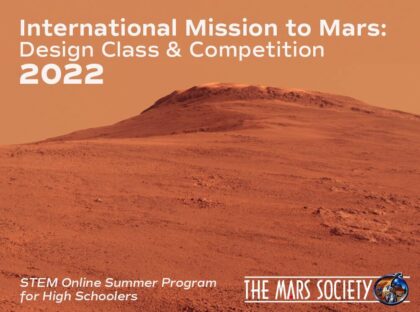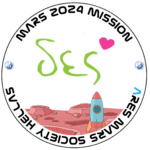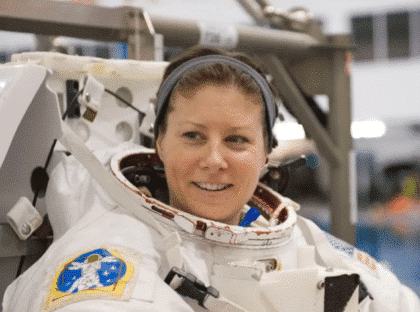
This summer, the Mars Society has been conducting a truly groundbreaking educational program for 40 high school students from around the world, modeled on the approach taken in engineering design courses at some of the best universities in the world.
With this six-week virtual program, which began on July 5th and will conclude in mid-August, the Mars Society looks to make educational history by demonstrating the value of a new and much more creative way to teach science and engineering at the secondary school level than is currently being practiced.
Tuition fee for the course was a nominal $50, making it possible for students of all economic levels to participate, while the worldwide nature of the program resulted in a diverse and multicultural group of high school students.
During the program, the students have been encouraged to communicate and collaborate using whatever tools and methods they were most comfortable with. They were organized into five separate teams based on the time zone each student resided in, as well as the desired working times they self-reported.
The participants are currently working to develop their own unique first human exploration missions to the Red Planet, after having been provided background lectures via Zoom video conferencing by some of the most prominent Mars experts in the world on a wide variety of topics. These include how to search for life on Mars, how to design spacesuits and other critical mission elements, and the science and technologies behind Mars exploration.
Guest lecturers included:
- Dr. James Bell, principal investigator of the Mastcam-Z camera system on NASA’s Perseverance rover, who shared the latest techniques and approaches for exploring Mars with rover-based science instruments.
- Dr. Steven Benner, an expert microbiologist who covered the nature of DNA and RNA and how to detect life signatures.
- Dr. Carol Stoker, a NASA Ames scientist who discussed concepts and approaches for searching for life on Mars, as well as past attempts.
- Dr. Chris McKay, a NASA Ames researcher who covered his work in searching for life on the Red Planet and in extreme environments on Earth.
- Homer Hickam, the author of “Rocket Boys” (which was made into the movie “October Sky”), who shared his experiences with rocketry as a high schooler in the 1950s and as a NASA employee during the Space Shuttle era in support of astronaut training.
- Dr. Lawrence Kuznetz, a former Apollo mission controller who is also an expert on lunar & Mars surface EVA suits.
- Dr. Greg Autry, a space policy expert with Arizona State University who provided a professional roadmap for students interested in pursuing space careers.
- Dr. Reut Sorek Abramovich, founder of the D-MARS analog program based in Israel, who is an expert on field science and astrobiology.
- Dr. Geoffrey Landis, NASA scientist and science fiction author, who discussed his work on NASA’s Mars Pathfinder and Mars Polar Lander missions.
- Dr. Madhu Thangavelu, an expert on lunar exploration from the University of Southern California.
- Dr. David Poston, formerly with Los Alamos National Laboratory and an expert on the use of nuclear power in space.
- Dr. Nathaniel Putzig, a scientist from the Planetary Science Institute and expert on mapping water ice on Mars.
- Ashwini Ramesh, an aerospace engineer and educator, who has researched the approaches to grow and create all types of food on Mars.
- Dr. Ken Brandt, a NASA Solar System Ambassador, who covered past failures and successes of Mars missions as well as landing site selection criteria.
- Caleb Eastman, an engineering expert, who focuses on both hardware and software robotics technologies.
The Mars Society has made nearly all of these educational lectures available to the general public via our YouTube Channel.
The high school students are now designing their Mars surface mission, including its habitat, surface vehicles, scientific instruments, power system and other equipment and supplies, crew size and composition, mission location, scientific objectives, rations, duration, and exploration plan. They have 30 metric tons of useful payload that has already been delivered to the Martian surface, plus an ascent vehicle capable of returning up to six astronauts from Mars to Earth.
The students are also creating mission design elements with four major factors in mind: Science, Engineering, Human Operational Challenges, and Cost. Optimizing any of these necessarily conflicts with the rest. For example, more science equipment will add weight, which takes away mass that could be used for additional exploration range or sacrificing the amount of support equipment, and doing anything better nearly always adds to cost. So, in addition to handling their own area as well as they can, the students must try to work out the best possible compromises to produce the best overall result.
The designs of each team will be written up in a report, with each team member responsible for authoring a section. In addition, eight coaches/mentors are also assisting and supporting the students with their design work and presentation preparation activities.
In a couple of weeks, the five teams will be virtually presenting their mission design elements in verbal, visual and written form to an expert panel of judges who will rate their designs based on their technical and scientific merit and how they address the four major factors.
The Mars mission designs will be published by the Mars Society in a book, which will be available for sale on Amazon.com. Students who are participating in the design activities will receive a certificate attesting to their participation, useful for augmenting their college entry applications. In addition, the winning design team will be invited to present their proposal at the 2022 International Mars Society Convention this October at Arizona State University.
The International Mission to Mars program wraps up in mid-August, with the Mars Society hoping to repeat and even expand this program next year.
Stay tuned to this webpage for more details about the program as time progresses.


